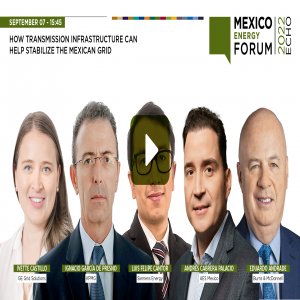
Transmission, Distribution: Challenges of the Future
 By Antonio Gozain | Senior Journalist and Industry Analyst -
Wed, 09/01/2021 - 19:08
By Antonio Gozain | Senior Journalist and Industry Analyst -
Wed, 09/01/2021 - 19:08
You can watch the video of this panel here.
Mexico’s transmission and distribution lines face all kinds of challenges, from geographical to operational. While the grid is mature and no expansion plans are in the works, it does need modernization to help the country head toward a brighter future, according to industry experts.
“There is 20, 25, 30-year-old equipment, also analog tools still migrating to digital. Given Mexico’s geography, this grid is exposed to natural disasters, earthquakes and now also to new challenges due to climate change,” said Ivette Castillo, North LATAM Commercial Executive at GE Grid Solutions.
As it lays exposed outdoors, the grid could suffer many types of damages, which is forcing operators to use budgets for operational and repairing purposes rather than in its modernization. The grid is also “exposed to demand and consumers’ behavioral changes caused by the pandemic because people are consuming differently and using more devices. Also, industrial users are changing consumption behavior,” said Castillo. These changes are making it impossible to ignore the issues the grid faces.
Whether it is modernizing the grid or recurring to battery energy storage and hybrid systems, it is urgent to take action in Mexico with investments, explained Santiago Barcón, Director General of PQ Barcon. “When auctions opened, modern transmission lines that enable the use of renewables should have been constructed and not the other way around. Now, we do have renewables but cannot dispatch them,” said Barcón. He also warned that “The grid is reaching its renewables handle limit.”
Given the difficulties of operating the Mexican grid, CFE’s staff has to be ready for new challenges every day, said Fidelmar Molina, Government Affairs and Power Generation Business Development at Hitachi ABB Power Grids. Under these circumstances, Molina labeled CFE engineers and managers’ job as titanic: “Mexico has the best electrical engineers taking care of the grid, with a lot of experience in the managerial level.”
In terms of challenges for the grid across the world, natural disasters and the renewables transition are not inherent to Mexico, according to Molina. “CFE has the same worries as other electric companies in the world and is following the same path as them, aiming to make the grid digital, intelligent and more resilient. For instance, the US$1 trillion infrastructure plan includes US$70 billion destined exclusively to electricity, with only US$2.5 billion intended for new transmission lines and roughly US$15 billion to make a more resilient grid,” said Molina.
The progress made with the combination of fossil fuels and renewable resources brought new challenges to the electricity industry and challenged the stability within the grid. However, supporting technologies, such as synchronous, voltage and balance condensers, help alleviating this instability.
“Technology is very important. We need monitoring to understand where and why failures happen. There is a lot of protection, production, automation and monitoring technology and intelligent systems not only on our grid, but across the world,” said Castillo. He also highlighted that capacity limitation and climate change were the main issues challenging the Mexican grid. “We should be talking about reducing the impact to the planet, decarbonizing our generation base. We have to talk about modernization and technology but also about our responsibility and investments to reduce the climate change,” added Castillo.
The grid code also plays a key role in the transmission and distribution lines, so both the private and public sectors have to work together to ensure the stability and reliability of Mexico’s transmission and distribution infrastructure, according to Barcón. “The grid code, published five years ago, aimed to change the regulation in the load centers. There used to be a lot of discretion in this regard and industrials complained about it. However, now they are still having problems with these regulations and there is an inconsistency there. We want the generation side to be upheld but we do not want to be subject to the grid code because it is very costly,” said Barcón.
There is a wrong perception in the industry about the system and how responsibilities should be shared, said Molina. He explained that CFE is not the only one responsible of the grid’s stability because everyone in the industry has to contribute. “It is a shared responsibility. For instance, from everybody turning on the A/C in Sinaloa at the same time to an electronic oven in a steel plant or wind farms, all our actions matter,” said Molina.
Mexico’s transmission and distribution future will depend on important investments, on how the grid is modernized and on the collaborative work of key players, both public and private, to help maintain its stability as it transitions to more efficient, cleaner energy sources.
















